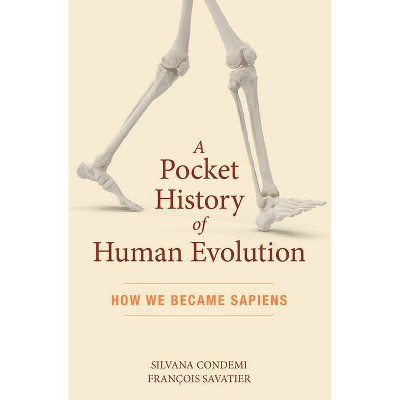Human Evolution - 4th Edition by Bernard Campbell (Paperback)

Similar Products
Products of same category from the store
AllProduct info
<p/><br></br><p><b> About the Book </b></p></br></br>In this new fourth edition, Campbell has revised and updated his classic introduction to the field<p/><br></br><p><b> Book Synopsis </b></p></br></br>In this new fourth edition, Campbell has revised and updated his classic introduction to the field. Human Evolution synthesizes the major findings of modern research and theory and presents a complete and integrated account of the evolution of human beings. New developments in microbiology and recent fossil records are incorporated into the enormous range of this volume, with the resulting text as lucid and comprehensive as earlier editions. The fourth edition retains the thematic structure and organization of the third, with its cogent treatment of human variability and speciation, primate locomotion, and nonverbal communication and the evolution of language, supported by more than 150 detailed illustrations and an expanded and updated glossary and bibliography. As in prior editions, the book treats evolution as a concomitant development of the main behavioral and functional complexes of the genus Homo- among them motor control and locomotion, mastication and digestion, the senses and reproduction. It analyzes each complex in terms of its changing function, and continually stresses how the separate complexes evolve interdependently over the long course of the human journey. All these aspects are placed within the context of contemporary evolutionary and genetic theory, analyses of the varied extensions of the fossil record, and contemporary primatology and comparative morphology. The result is a primary text for undergraduate and graduate courses, one that will also serve as required reading for anthropologists, biologists, and nonspecialists with an interest in human evolution.<p/><br></br><p><b> Review Quotes </b></p></br></br><br><p> -Synthesizes the conventional academic thought into a textbook or detailed account for lay readers. Along the chronological narrative are discussions of progress in homeostasis, the primate radiation, locomotion and the hindlimb, function and structure of the head, reproduction and social structure, and culture and society.-</p> <p> <i>--Book News </i></p> <p> -[T]he grand design is remarkably clear and well-illustrated presentation is beautifully lucid. This very instructive book may be read, with pleasure, by those who seek to learn about the orthodox aspects of the evolution of man and his forebears, as well as by those who seek the better to understand the complex interplay of social and biological factors which influences and determined the emergence and evolution of man.-</p> <p> --Eric Sunderland, <em>RAIN</em></p> <p> -There is no doubt that the book is an adventurous one both in its planning and in its inclusion of new research--even untested research--in the appropriate sections. The author is fully aware of this calculated risk.-</p> <p> --David R. Hughes, <em>Man</em></p> <p> -The effects of physiological and functional characteristics on social and cultural evolution are very well considered and mark an important contribution to thinking about human biology, as well as providing perspective. Clear definitions within the text and a useful glossary will aid the student, and even the nonbiologists will find much of interest.-</p> <p> --H. B. S. Cooke, <em>The Quarterly Review of Biology</em></p> <p> -This is an original and a welcome book. Actually, the approach is so appropriate one wonders why it was not done earlier, but it is fortunate to have been written by Campbell, who has a fine sense of organization and a graceful and pithy style of writing.... [C]arefully and clearly done.... Since the book is not an attempt to be up-to-date on fossil remains, it will have a long and useful life.-</p> <p> --W. W. Howells, <em>American Scientist</em></p> <p> -Dr. Campbell's most important original contribution to problems of human evolution has been on the subject of Primate taxonomy. In this book he has assembled evidence from a much wider field for a presentation of the main factors that have led to the distinctive adaptations of man to his environment.... The author has aimed to make his book intelligible to readers with no previous knowledge of biology and, with the help of an extenstive glossary, his aim has been most successfully achieved. No doubt this is the main virtue of the book, for it has been written in a style that is even exciting for the non-specialist.-</p> <p> --Wilfrid Le Gros Clark, <em>The British Medical Journal</em></p> <p> -[T]his book should have a broad appeal. It certainly is well adapted for use in college courses on human evolution, physical anthropology, and comparative vertebrate biology.-</p> <p> --William L. Straus, Jr., <em>The Quarterly Review of Biology</em></p><br><br><p> "Synthesizes the conventional academic thought into a textbook or detailed account for lay readers. Along the chronological narrative are discussions of progress in homeostasis, the primate radiation, locomotion and the hindlimb, function and structure of the head, reproduction and social structure, and culture and society."</p> <p> <i>--Book News </i></p> <p> "[T]he grand design is remarkably clear and well-illustrated presentation is beautifully lucid. This very instructive book may be read, with pleasure, by those who seek to learn about the orthodox aspects of the evolution of man and his forebears, as well as by those who seek the better to understand the complex interplay of social and biological factors which influences and determined the emergence and evolution of man."</p> <p> --Eric Sunderland, <em>RAIN</em></p> <p> "There is no doubt that the book is an adventurous one both in its planning and in its inclusion of new research--even untested research--in the appropriate sections. The author is fully aware of this calculated risk."</p> <p> --David R. Hughes, <em>Man</em></p> <p> "The effects of physiological and functional characteristics on social and cultural evolution are very well considered and mark an important contribution to thinking about human biology, as well as providing perspective. Clear definitions within the text and a useful glossary will aid the student, and even the nonbiologists will find much of interest."</p> <p> --H. B. S. Cooke, <em>The Quarterly Review of Biology</em></p> <p> "This is an original and a welcome book. Actually, the approach is so appropriate one wonders why it was not done earlier, but it is fortunate to have been written by Campbell, who has a fine sense of organization and a graceful and pithy style of writing.... [C]arefully and clearly done.... Since the book is not an attempt to be up-to-date on fossil remains, it will have a long and useful life."</p> <p> --W. W. Howells, <em>American Scientist</em></p> <p> "Dr. Campbell's most important original contribution to problems of human evolution has been on the subject of Primate taxonomy. In this book he has assembled evidence from a much wider field for a presentation of the main factors that have led to the distinctive adaptations of man to his environment.... The author has aimed to make his book intelligible to readers with no previous knowledge of biology and, with the help of an extenstive glossary, his aim has been most successfully achieved. No doubt this is the main virtue of the book, for it has been written in a style that is even exciting for the non-specialist."</p> <p> --Wilfrid Le Gros Clark, <em>The British Medical Journal</em></p> <p> "[T]his book should have a broad appeal. It certainly is well adapted for use in college courses on human evolution, physical anthropology, and comparative vertebrate biology."</p> <p> --William L. Straus, Jr., <em>The Quarterly Review of Biology</em></p><br><br><P> "Synthesizes the conventional academic thought into a textbook or detailed account for lay readers. Along the chronological narrative are discussions of progress in homeostasis, the primate radiation, locomotion and the hindlimb, function and structure of the head, reproduction and social structure, and culture and society." <P> "--Book News " <P> "[T]he grand design is remarkably clear and well-illustrated presentation is beautifully lucid. This very instructive book may be read, with pleasure, by those who seek to learn about the orthodox aspects of the evolution of man and his forebears, as well as by those who seek the better to understand the complex interplay of social and biological factors which influences and determined the emergence and evolution of man." <P> --Eric Sunderland, RAIN <P> "There is no doubt that the book is an adventurous one both in its planning and in its inclusion of new research--even untested research--in the appropriate sections. The author is fully aware of this calculated risk." <P> --David R. Hughes, Man <P> "The effects of physiological and functional characteristics on social and cultural evolution are very well considered and mark an important contribution to thinking about human biology, as well as providing perspective. Clear definitions within the text and a useful glossary will aid the student, and even the nonbiologists will find much of interest." <P> --H. B. S. Cooke, The Quarterly Review of Biology <P> "This is an original and a welcome book. Actually, the approach is so appropriate one wonders why it was not done earlier, but it is fortunate to have been written by Campbell, who has a fine sense of organization and a graceful and pithy style of writing.... [C]arefully and clearly done.... Since the book is not an attempt to be up-to-date on fossil remains, it will have a long and useful life." <P> --W. W. Howells, American Scientist <P> "Dr. Campbell's most important original contribution to problems of human evolution has been on the subject of Primate taxonomy. In this book he has assembled evidence from a much wider field for a presentation of the main factors that have led to the distinctive adaptations of man to his environment.... The author has aimed to make his book intelligible to readers with no previous knowledge of biology and, with the help of an extenstive glossary, his aim has been most successfully achieved. No doubt this is the main virtue of the book, for it has been written in a style that is even exciting for the non-specialist." <P> --Wilfrid Le Gros Clark, The British Medical Journal <P> "[T]his book should have a broad appeal. It certainly is well adapted for use in college courses on human evolution, physical anthropology, and comparative vertebrate biology." <P> --William L. Straus, Jr., The Quarterly Review of Biology<br>
Price History
Cheapest price in the interval: 52.95 on November 6, 2021
Most expensive price in the interval: 52.95 on February 4, 2022
Price Archive shows prices from various stores, lets you see history and find the cheapest. There is no actual sale on the website. For all support, inquiry and suggestion messagescommunication@pricearchive.us




















